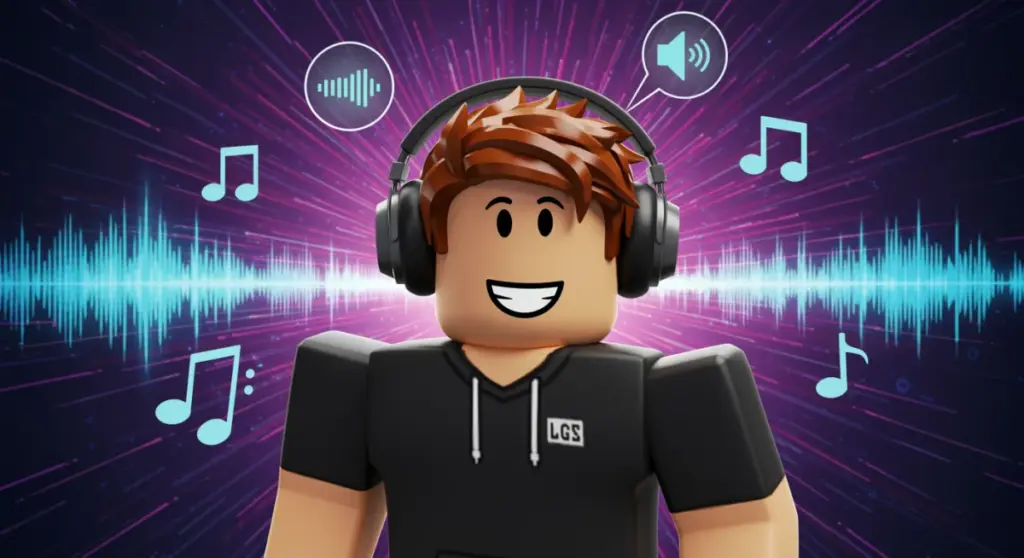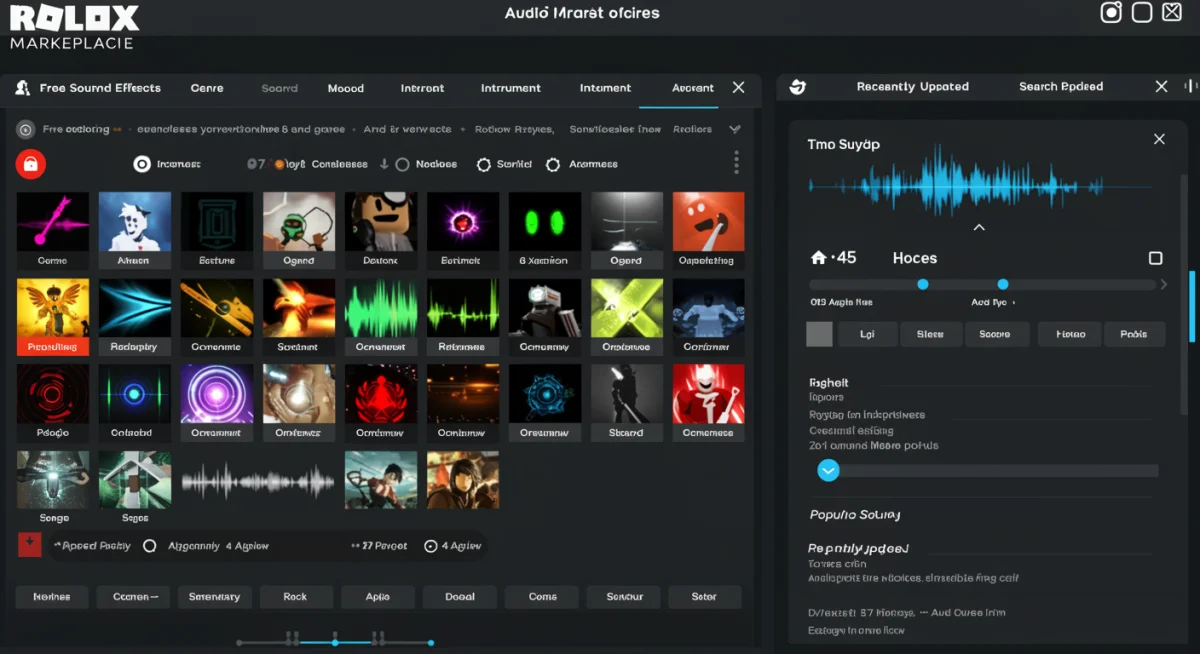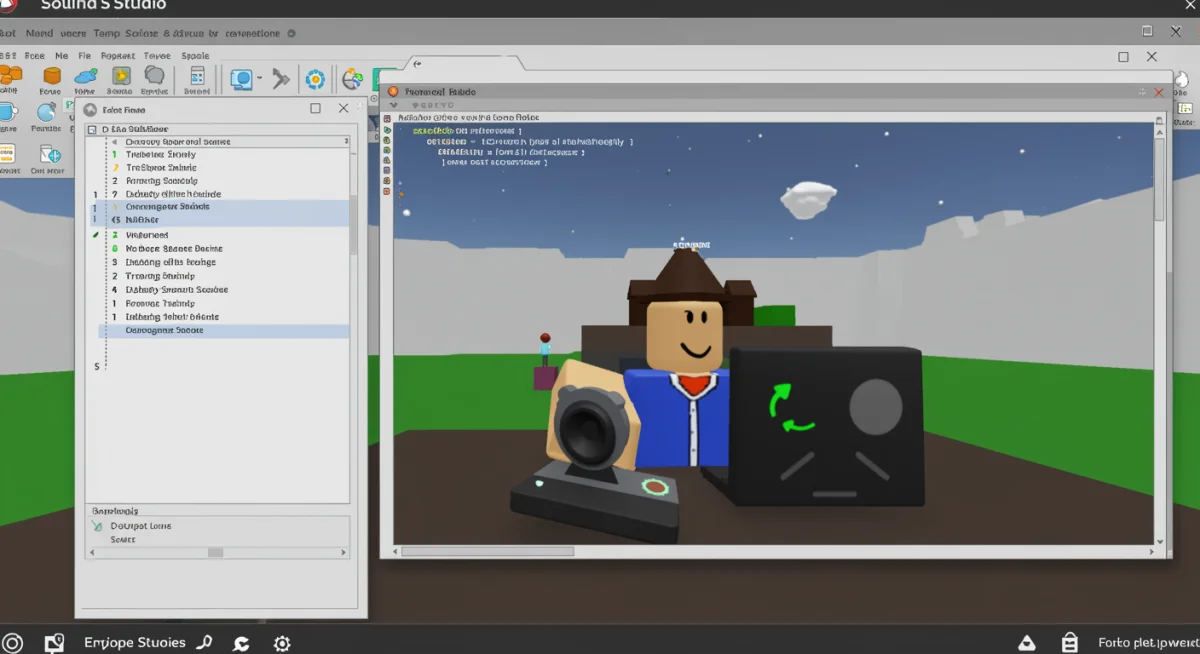Roblox Audio Secrets: Find Free Sound Effects and Music for Your Games

Anúncios
Discovering Roblox Audio Secrets involves leveraging the platform’s vast resources and external libraries to find free sound effects and music, significantly enhancing game immersion and player experience without incurring costs.
Are you ready to elevate your Roblox game development? Unlocking Roblox Audio Secrets is crucial for creating truly immersive and memorable player experiences. Sound effects and music aren’t just background noise; they are vital tools for setting atmosphere, conveying information, and evoking emotions, all without spending a dime on premium content.
Understanding the Importance of Audio in Roblox Games
Audio is an often-underestimated component of game design, yet it holds immense power to transform a good game into a great one. In Roblox, where creators have the freedom to build anything imaginable, sound plays a critical role in bringing those worlds to life. From the subtle rustle of leaves in a forest to the triumphant fanfare of completing a quest, well-placed audio cues can dramatically enhance player engagement and immersion.
Without appropriate sound, even the most visually stunning Roblox experiences can feel hollow or incomplete. Audio guides players, signaling events, successes, failures, and even dangers. It contributes significantly to the overall mood and atmosphere, making the virtual environment feel more real and responsive. This section will delve into why prioritizing audio is a non-negotiable step for any aspiring Roblox developer.
The Psychological Impact of Sound
The human brain processes sound with incredible speed and efficiency, often reacting to auditory cues before visual ones. In games, this translates to an immediate emotional and cognitive response. A sudden, jarring sound can create tension, while a calming melody can induce relaxation. Understanding these psychological principles allows developers to manipulate player emotions and guide their experience more effectively.
- Emotional Connection: Music and sound effects can forge powerful emotional bonds between players and the game world, making experiences more memorable.
- Feedback and Immersion: Sounds provide crucial feedback for player actions, like footsteps, weapon impacts, or item collection, making interactions feel more tangible.
- Atmosphere and Setting: Ambient sounds and background music are essential for establishing the game’s setting and mood, whether it’s a spooky dungeon or a bustling city.
- Narrative Enhancement: Audio can underscore storytelling, highlighting key plot points or character developments.
By carefully selecting and implementing audio, developers can create a richer, multi-sensory experience that captivates players and keeps them coming back. The goal is to create an auditory landscape that complements the visual one, building a cohesive and immersive world.
In conclusion, recognizing the profound impact of audio on player experience is the first step towards mastering Roblox game development. It’s not just about adding sounds; it’s about strategically using audio to enhance immersion, provide feedback, and create emotional depth, ultimately leading to a more polished and engaging game.
Leveraging the Roblox Creator Marketplace for Free Audio
The Roblox Creator Marketplace is an invaluable resource for developers seeking assets, and its audio section is a treasure trove of free sound effects and music. Many creators overlook the sheer volume and quality of audio available directly within Roblox, assuming they need to look elsewhere. However, the Marketplace offers a curated collection that is often perfectly suited for Roblox games, ensuring compatibility and ease of integration.
Navigating the Marketplace efficiently is key to finding the best audio for your project. With robust search functionalities and categories, you can quickly pinpoint sounds that match your game’s theme and requirements. This section will guide you through the process of effectively utilizing this built-in resource to enhance your game’s auditory landscape.
Effective Search Strategies within the Marketplace
To maximize your chances of finding high-quality, free audio, it’s essential to employ smart search techniques. Start with specific keywords related to the sound you need. For instance, instead of just searching for “music,” try “adventure music,” “ambient forest sounds,” or “sci-fi weapon blast.” The more precise your terms, the better your results will be.
- Filter by ‘Free’: Always apply the ‘Free’ filter to ensure you’re only browsing assets that won’t cost Robux.
- Sort by ‘Most Popular’ or ‘Recently Updated’: Popular items often indicate quality, while recent additions might offer fresh sounds.
- Check Creator Reputation: Look for audio uploaded by reputable creators or Roblox itself, as these often guarantee higher quality and proper licensing.
- Preview Sounds: Always listen to a sound effect or music track before downloading it. What sounds good in theory might not fit your game’s aesthetic upon hearing.
Remember that the Marketplace is constantly updated, so what you can’t find today might be available tomorrow. Regular checks can yield new and exciting audio assets for your projects. Also, consider combining terms to narrow down your search even further, such as “epic battle music loop” or “cartoon jump sound.”
The Roblox Creator Marketplace is a powerful tool for any developer seeking to enrich their games with audio. By understanding how to effectively search, filter, and evaluate the available assets, you can discover a wealth of free sound effects and music that will significantly elevate your game’s appeal and immersion without incurring any development costs.

Exploring External Libraries for Copyright-Free Audio
While the Roblox Creator Marketplace is a fantastic starting point, sometimes your game might require a unique sound that isn’t readily available there. This is where external, copyright-free audio libraries become invaluable. The internet hosts a vast array of websites dedicated to providing royalty-free sound effects and music that you can use in your Roblox games without worrying about legal repercussions or licensing fees. However, it’s crucial to understand the nuances of various licenses to ensure compliance.
Diving into these external resources can significantly expand your audio palette, allowing for greater creativity and distinction in your game’s sound design. This section will introduce you to some of the most reliable platforms and explain how to navigate their licensing terms effectively.
Top External Resources for Free Audio
Several websites specialize in offering high-quality, copyright-free audio. These platforms often categorize sounds meticulously, making it easier to find exactly what you need. Always double-check the specific license for each asset, as terms can vary even within the same website.
- Freesound.org: A collaborative database of audio snippets, samples, recordings, and bleeps released under Creative Commons licenses. It’s a goldmine for unique sound effects.
- Incompetech.com: Kevin MacLeod’s extensive collection of royalty-free music, all available under a Creative Commons Attribution license, requiring only credit.
- Pixabay: Known for free images, Pixabay also offers a growing library of free music and sound effects, often with a simple license that permits commercial use without attribution.
- YouTube Audio Library: YouTube provides a vast collection of free music and sound effects for creators, accessible directly from your YouTube Studio dashboard.
- OpenGameArt.org: While primarily for game art, it also hosts a decent collection of free sound effects and music tailored for game development.
When using external assets, always download the highest quality version available and convert it to an appropriate format for Roblox (usually .ogg or .mp3) if necessary. Pay close attention to any attribution requirements; some licenses demand that you credit the original creator in your game’s description or credits section.
Exploring external libraries opens up a world of possibilities for enriching your Roblox game’s audio. By understanding where to look and how to interpret licensing terms, developers can access a diverse range of high-quality, free sound effects and music, ensuring their games stand out with professional-grade audio without any cost.
Optimizing Audio for Roblox Studio: Formats and Integration
Finding the perfect sound effect or music track is only half the battle; the other half is successfully integrating it into your Roblox game and optimizing it for performance. Roblox Studio has specific requirements and best practices for audio files, and adhering to these will ensure your game runs smoothly and sounds great. Incorrect formats or overly large files can lead to performance issues, lag, and a less enjoyable player experience.
This section will cover the technical aspects of preparing your audio files for Roblox, including recommended formats, file size considerations, and the step-by-step process of importing and scripting sounds within Roblox Studio. Mastering these techniques is vital for any developer looking to implement Roblox Audio Secrets effectively.
Recommended Audio Formats and File Size Management
Roblox Studio primarily supports MP3 and OGG file formats for audio. OGG is often preferred for its smaller file sizes and better compression without significant loss of quality, especially for longer tracks or ambient sounds. MP3s are widely compatible and also work well, but be mindful of their size.
- MP3 (MPEG Audio Layer III): Good for general use, widely supported. Aim for a bitrate of 128-192 kbps for music and 64-128 kbps for sound effects to balance quality and file size.
- OGG (Ogg Vorbis): Excellent for smaller file sizes with comparable quality to MP3. Ideal for background music and lengthy ambient tracks.
- WAV (Waveform Audio File Format): While supported, WAV files are uncompressed and can be very large, making them less suitable for game assets unless very short and critical sounds. Convert WAV to OGG or MP3 before uploading.
File size is a critical consideration. Large audio files can increase load times and consume more memory, impacting game performance, especially on lower-end devices. Always aim to compress your audio files without sacrificing too much quality. Many free online tools and desktop applications can help you convert and compress audio.
When uploading audio to Roblox, the platform itself will often re-encode files to optimize them. However, starting with an already optimized file will give you better control over the final quality. Keep individual audio files under 10MB if possible, and break longer tracks into smaller segments if necessary.
Once your audio files are optimized, importing them into Roblox Studio is straightforward. You’ll use the ‘Asset Manager’ to upload your sounds, which then become available for use in your game. From there, you can insert ‘Sound’ objects into your game’s hierarchy and configure their properties, such as volume, looping, and playback speed. Scripting is then used to trigger these sounds based on in-game events.
Optimizing audio for Roblox Studio is a crucial step in ensuring your game not only sounds great but also performs efficiently. By understanding the best file formats, managing file sizes, and properly integrating sounds through the Asset Manager and scripting, developers can create a polished and immersive audio experience for their players.
Scripting Audio: Bringing Sounds to Life in Your Game
Once you’ve found and optimized your audio files, the next crucial step is to integrate them dynamically into your Roblox game using Lua scripting. Simply having sounds in your Asset Manager isn’t enough; you need to tell Roblox Studio when and how to play them. Scripting allows you to create interactive audio experiences, from background music that changes with game states to specific sound effects that trigger upon player actions or environmental events.
This section will demystify the process of scripting audio in Roblox Studio, providing practical examples and best practices to ensure your sounds enhance gameplay rather than detract from it. Mastering audio scripting is fundamental to truly leveraging Roblox Audio Secrets.
Basic Audio Scripting Techniques
The core of audio scripting in Roblox revolves around the ‘Sound’ object. When you upload an audio file, it becomes an ‘AudioId’ that you can assign to a ‘Sound’ object. These ‘Sound’ objects can be placed anywhere in your game’s hierarchy, such as inside a part, a character, or even in ‘SoundService’ for global control.
- Playing a Sound: The most basic command is
SoundObject:Play(). This will start playing the sound assigned to theSoundObject. - Stopping a Sound: To stop a playing sound, use
SoundObject:Stop(). - Looping: For background music or ambient sounds, set the
SoundObject.Loopedproperty totrue. - Volume Control: Adjust
SoundObject.Volume(a number between 0 and 1) to control how loud the sound is. - Pitch Adjustment: Alter
SoundObject.Pitchto change the speed and tone of the sound, creating interesting effects.
For instance, to play a sound when a player touches a specific part, you might write a script like this:
local part = script.Parent
local sound = part.Sound -- Assuming a Sound object named 'Sound' is inside the part
part.Touched:Connect(function(hit)
if sound and not sound.IsPlaying then
sound:Play()
end
end)
This simple script checks if the sound exists and isn’t already playing before triggering it. For background music, a script placed in ‘StarterPlayer/StarterPlayerScripts’ might look like this:
local soundService = game:GetService("SoundService")
local backgroundMusic = Instance.new("Sound")
backgroundMusic.SoundId = "rbxassetid://YOUR_AUDIO_ID_HERE"
backgroundMusic.Volume = 0.5
backgroundMusic.Looped = true
backgroundMusic.Parent = soundService
backgroundMusic:Play()
Advanced scripting can involve fading sounds in and out, creating spatial audio (3D sound), or dynamically changing music based on game events like entering combat or reaching a new area. Understanding these fundamental building blocks allows for complex and engaging audio experiences.
Scripting audio is where your sound assets truly come to life, transforming static files into dynamic elements of your game. By mastering basic commands and understanding how to trigger sounds based on in-game events, developers can create an auditory experience that significantly enhances player immersion and interaction within their Roblox creations.

Advanced Audio Techniques: Spatial Sound and Dynamic Music
Beyond basic sound playback, Roblox Studio offers advanced audio features that can significantly elevate the realism and immersion of your games. Spatial sound, also known as 3D audio, allows sounds to originate from specific points in your game world, changing in volume and panning as the player moves closer or further away, or shifts their camera angle. Dynamic music, on the other hand, involves changing musical tracks or elements based on in-game events or player states, creating a more responsive and engaging auditory narrative.
These techniques move beyond simple background loops and one-off sound effects, pushing the boundaries of what’s possible with Roblox Audio Secrets. This section will explore how to implement spatial audio and dynamic music to create a truly professional-grade soundscape.
Implementing Spatial Audio
Spatial audio is crucial for creating a believable and immersive environment. Imagine hearing a monster’s growl getting louder as you approach it, or a distant explosion echoing through a valley. Roblox Studio makes implementing spatial audio relatively straightforward.
- Parenting Sound Objects: To make a sound spatial, simply parent the ‘Sound’ object to a ‘Part’ in your game world. The sound will then emanate from that part’s position.
- RollOffMode and RollOffMaxDistance: These properties control how the sound’s volume decreases with distance.
RollOffMode.Inverseis a common choice for realistic falloff.RollOffMaxDistancedetermines the maximum range at which the sound can be heard. - PlaybackLoudness: While not directly spatial, understanding
PlaybackLoudnesscan help ensure your spatial sounds are appropriately balanced with other audio elements.
For example, attaching a sound of a campfire crackling to a campfire model will make the sound appear to come from the fire itself, getting louder as players approach and softer as they move away. This simple technique can dramatically increase immersion.
Creating Dynamic Music Systems
Dynamic music systems adapt to the player’s actions or game state, providing a more engaging and less repetitive auditory experience. Instead of a single looping track, dynamic music might transition between themes (e.g., exploration, combat, safe zone) or layer additional instruments as intensity builds.
One common approach is to use multiple ‘Sound’ objects, each containing a different music track or layer, and then use scripting to control their playback. For instance, you could have a ‘peaceful’ music track and a ‘combat’ music track. When combat begins, you might fade out the peaceful track and fade in the combat track.
local peacefulMusic = game.Workspace.MusicFolder.PeacefulTrack
local combatMusic = game.Workspace.MusicFolder.CombatTrack
function startCombatMusic()
peacefulMusic:Stop()
combatMusic:Play()
end
function endCombatMusic()
combatMusic:Stop()
peacefulMusic:Play()
end
-- Example of calling these functions based on game events
-- game.Players.PlayerAdded:Connect(function(player) ... end)
More sophisticated systems might involve layering different instrument tracks on top of each other, where certain layers are only played during specific events, creating a richer and more adaptive score. This requires careful composition or selection of music designed for layering.
Implementing spatial sound and dynamic music systems unlocks a new level of audio sophistication in your Roblox games. These techniques allow you to create environments that sound more realistic and respond intelligently to player actions, significantly enhancing the overall quality and immersion of your game world.
Best Practices for Integrating Audio into Your Game Design
Integrating audio effectively into your Roblox game design goes beyond technical implementation; it involves strategic planning and a keen understanding of how sound contributes to the overall player experience. Poorly placed or overwhelming audio can be as detrimental as no audio at all, leading to player annoyance or confusion. To truly master Roblox Audio Secrets, developers must adopt best practices that blend technical skill with thoughtful design principles.
This section outlines key considerations for game designers, focusing on balance, player feedback, and creating a cohesive auditory experience that complements, rather than competes with, other game elements.
Strategic Audio Placement and Volume Control
The placement and volume of your audio assets are critical. Not every action needs a loud, distinct sound effect, nor does every area require intense background music. A balanced approach ensures that important audio cues stand out without overwhelming the player.
- Contextual Relevance: Ensure sounds make sense within their context. A subtle splash for walking through shallow water is more effective than a booming ocean wave sound.
- Layering Sounds: Use multiple sound layers for ambiance (e.g., wind, distant birds, rustling leaves) but ensure they are individually balanced and don’t create a cacophony.
- Prioritize Important Sounds: Critical gameplay sounds (e.g., health alerts, quest completion, enemy warnings) should be audible and distinct.
- Volume Hierarchy: Establish a clear hierarchy for volume. Background music should generally be softer than sound effects, which in turn should be balanced against voice lines (if any).
- Player Control: Consider implementing in-game volume sliders for music and sound effects, allowing players to customize their audio experience.
Overuse of sound can lead to auditory fatigue, making players mute your game. Instead, use silence or subtle ambient sounds to create contrast and highlight moments when more prominent audio is introduced.
Another crucial aspect is using audio for clear and immediate player feedback. When a player performs an action, collects an item, or takes damage, a corresponding sound effect provides instant confirmation. This feedback loop is essential for player understanding and satisfaction.
Furthermore, maintain consistency in your audio design. If your game has a specific art style or theme, ensure your audio choices align with it. For example, a fantasy game might use orchestral music and natural sound effects, while a futuristic game would lean towards electronic music and synthesized sounds. This consistency helps build a cohesive and believable game world.
Integrating audio effectively is a blend of art and science. By adhering to best practices in placement, volume control, feedback, and consistency, developers can ensure their sound design enhances the overall game experience, making their Roblox creations truly shine.
Troubleshooting Common Roblox Audio Issues
Even with careful planning and implementation, developers may encounter issues with audio in their Roblox games. From sounds not playing to unexpected glitches, troubleshooting is a vital skill for maintaining a polished experience. Understanding common problems and their solutions can save considerable time and frustration, ensuring your game’s soundscape remains intact and functional. This section will address frequently encountered audio issues and provide practical steps to resolve them, helping you maintain the integrity of your Roblox Audio Secrets.
Being prepared for these challenges means you can quickly diagnose and fix problems, keeping your development process smooth and your players happy.
Diagnosing and Resolving Audio Playback Problems
One of the most common issues is a sound simply not playing. This can stem from several sources, ranging from incorrect asset IDs to scripting errors or even platform-specific limitations.
- Incorrect AudioId: Double-check that the
SoundIdproperty of your ‘Sound’ object is correct. It should be in the formatrbxassetid://[YOUR_AUDIO_ID], where[YOUR_AUDIO_ID]is the numeric ID of your uploaded asset. - Sound Object Not Found: Ensure your script correctly references the ‘Sound’ object. If it’s parented to a ‘Part’, the script should access it like
part.Soundorpart:FindFirstChild("Sound"). - Volume Set to Zero: Verify that the
Volumeproperty of the ‘Sound’ object is not set to 0. Also, check the user’s in-game volume settings. - Not Looping When Expected: If a sound is meant to loop but doesn’t, ensure the
Loopedproperty is set totrue. - File Format/Size Issues: Confirm the audio file is in a supported format (MP3, OGG) and not excessively large. Roblox may fail to load very large or unsupported files.
- Scripting Errors: Check the Output window in Roblox Studio for any errors related to your audio scripts. Syntax errors or logical flaws can prevent sounds from playing.
- Roblox Platform Restrictions: Occasionally, Roblox may moderate or temporarily disable audio assets that violate its terms of service. Check your asset status in the Creator Dashboard.
When troubleshooting, start with the simplest checks and gradually move to more complex ones. Use print() statements in your scripts to confirm if code sections are executing as expected, or if variables (like the sound object itself) are correctly defined.
Another common issue is audio cutting out or distorting. This can be due to performance issues, where the game engine struggles to process all active sounds. Reducing the number of simultaneously playing sounds, optimizing script efficiency, and ensuring audio files are well-compressed can help mitigate these problems.
Finally, test your audio across different devices and internet connections. What works perfectly on a high-end PC might struggle on a mobile device or with a slow internet connection. Cross-platform testing is crucial for a consistent player experience.
Troubleshooting audio issues is an integral part of game development. By systematically checking common pitfalls and utilizing Roblox Studio’s debugging tools, developers can effectively resolve problems, ensuring their game’s audio design remains robust and enjoyable for all players.
| Key Aspect | Brief Description |
|---|---|
| Roblox Marketplace | Primary source for free, compatible sound effects and music directly within Roblox Studio. |
| External Libraries | Websites like Freesound.org and Incompetech offer diverse copyright-free audio with various licenses. |
| Audio Optimization | Use MP3/OGG formats, compress files, and manage sizes for optimal performance in Roblox Studio. |
| Scripting & Design | Implement sounds with Lua scripts, utilize spatial audio, and follow best practices for balanced game design. |
Frequently Asked Questions About Roblox Audio
No, you cannot use just any audio. You must ensure the audio is copyright-free or licensed for use in games, especially for commercial purposes. Always check the licensing terms. The Roblox Creator Marketplace and specific copyright-free external libraries are safe sources for obtaining audio legally.
Roblox Studio primarily supports MP3 and OGG formats. OGG is often preferred due to its efficient compression and smaller file sizes, which can help improve game performance. While WAV is supported, its uncompressed nature makes it less ideal for extensive in-game audio.
To make a sound loop, find the ‘Sound’ object in Roblox Studio’s Explorer window. In the Properties window, locate the ‘Looped’ property and check the box next to it. This will ensure the sound plays continuously until explicitly stopped by a script.
Common reasons include an incorrect ‘SoundId’, the ‘Sound’ object not being parented correctly, its ‘Volume’ property being set to 0, or errors in your Lua script. Always check the Output window for errors, verify your AudioId, and confirm the sound object is accessible to your script.
Spatial audio, or 3D audio, makes sounds appear to originate from a specific location in your game world, with volume and panning changing as the player moves. It significantly enhances immersion by making the game environment feel more realistic and responsive, guiding players with auditory cues.
Conclusion
Mastering Roblox Audio Secrets is an indispensable skill for any developer aiming to create truly exceptional and immersive games. From strategically sourcing free sound effects and music from the Creator Marketplace and external libraries to optimizing files for performance and implementing dynamic audio systems through scripting, every step contributes to a richer player experience. By understanding the profound impact of sound on emotion and engagement, and by adhering to best practices in audio design and troubleshooting, you can elevate your Roblox creations from good to unforgettable, ensuring your players are not just playing your game, but truly living it.





